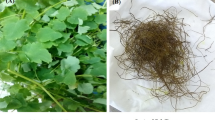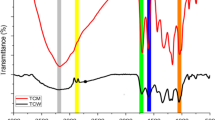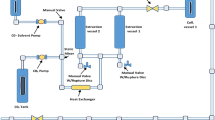Abstract
The leaves of Pteropyrum scoparium Jaub & Spach are used by the locals in Oman for treating various stomach infirmities including dyspepsia. No analysis of this species in terms of bioactive composition is reported, however members of this family are reported to contain flavonoids and anthraquinones. This study aimed to explore the bioactive compounds in the Pteropyrum scoparium Jaub & Spach leaves and optimize the bioactive compound extraction process using green solvents such as water, 30 % aqueous glycerol and ethanol. We compared the extraction ability of the solvents by estimate the polyphenols and further evaluated the flavonoids and radical scavenging capacity of the liquid crude extract (LCE) s. We also screened the LCEs for presence of any antibacterial ability on selected ATCC gram positive and gram negative bacterial strains. We established the identification data by recording the botanical characters of the leaves using scanning electron microscopy (SEM) so that the future identification and quality assessment can have strong basis. In extraction process we found the 30 % aqueous glycerol to be most efficient solvent in extraction yield of polyphenols followed by water. However, water LCE was found to be highest in the total flavonoids as well as in radical scavenging capacity. Anti-bacterial screening showed average inhibitory effect on the bacterial growth, interestingly the ethanol LCE showed activity against the gram negative E. coli. Overall as we optimized the extraction process for the leaves of Pteropyrum scoparium Jaub & Spach using green solvents, it is considered safe and offers great potential for further purification and application in future studies.

Similar content being viewed by others
References
Ahmed Abdo-Rabbo MA-A, Brian C Gunn, Hawraa Al-Lawati, Batool J Suleiman (2009) Household Survey on Medicine Use in Oman.
Al-zoreky NS, Al–Taher AY (2015) Antibacterial activity of spathe from Phoenix dactylifera L. against some food-borne pathogens. Ind Crop Prod 65:241–246. doi:10.1016/j.indcrop.2014.12.014
Armenta S, Garrigues S, de la Guardia M (2015) The role of green extraction techniques in green analytical chemistry TrAC Trends in Analytical Chemistry
Aslam F, Rehman K, Asghar M, Sarwar M (2009) Antibacterial activity of various phytoconstituents of Neem Pak. J Agric Sci 46:209–213
Bhakuni DS, Dhar M, Dhar M, Dhawan B, Mehrotra B (1969) Screening of Indian plants for biological activity: Part II Indian. J Exp Biol 7:250–262
Boulekbache-Makhlouf L, Slimani S, Madani K (2013) Total phenolic content, antioxidant and antibacterial activities of fruits of Eucalyptus globulus cultivated in Algeria. Ind Crop Prod 41:85–89. doi:10.1016/j.indcrop.2012.04.019
Chand P, Shaik S, Sadath A, Ziaullah K (2008) Antisalmonella Activity of Selected Medicinal Plants. Turk J Biol 33:59–64
Crowe KM, Allison D (2015) Evaluating Bioactive Food Components in Obesity and Cancer. Prevention Critical reviews in food science and nutrition 55:732–734
Czuchajowska Z (2015) Seasonal changes of pH and buffer capacity of aqueous homogenates of Vaccinium vitis-idaea and Vaccinium myrtillus leaves. Acta Soc Bot Pol 48:35–46
Dahiya P, Purkayastha S (2012) Phytochemical screening and antimicrobial activity of some medicinal plants against multi-drug resistant bacteria from clinical isolates. Indian journal of pharmaceutical sciences 74:443
Djerrad Z, Kadik L, Djouahri A (2015) Chemical variability and antioxidant activities among Pinus halepensis mill. Essential oils provenances, depending on geographic variation and environmental conditions. Ind Crop Prod 74:440–449. doi:10.1016/j.indcrop.2015.05.049
Eloff J (1998) Which extractant should be used for the screening and isolation of antimicrobial components from plants? J Ethnopharmacol 60:1–8
Ensikat H, Ditsche-Kuru P, Barthlott W, Méndez-Vilas A, Díaz J (2010) Scanning electron microscopy of plant surfaces: simple but sophisticated methods for preparation and examination Microscopy: Science, technology, applications and education 1:248–255
Essa MM, Guillemin G, Al-Rawahi A, Singh V, Guizani N, Memon A (2012) Walnuts (Juglans regia linn) and its health benefits
Fernandes MRV, Dias ALT, Carvalho RR, Souza CRF, Oliveira WP (2014) Antioxidant and antimicrobial activities of Psidium guajava L. spray dried extracts Industrial Crops and Products 60:39–44 doi:10.1016/j.indcrop.2014.05.049
Ghazanfar SA (1994) Handbook of Arabian medicinal plants. CRC press
Gu Y, Jérôme F (2010) Glycerol as a sustainable solvent for green chemistry. Green Chem 12:1127–1138
Guizani N, Waly MI, Ali A, Al-Saidi G, Singh V, Bhatt N, Rahman MS (2011) Papaya epicarp extract protects against hydrogen peroxide-induced oxidative stress in human SH-SY5Y neuronal cells. Experimental Biology and Medicine 236:1205–1210
Guizani N, Essa MM, Al-Kharousi Z, Singh V, Soussi B, Guillemin G (2012) Omega 3 fatty acids and its potential health benefits
Guizani N, Waly MI, Singh V, Rahman MS (2013) Nabag (Zizyphus spina-christi) extract prevents aberrant crypt foci development in colons of azoxymethane-treated rats by abrogating oxidative stress and inducing apoptosis. Asian Pac J Cancer Prev 14:5031–5035
Gyamfi MA, Yonamine M, Aniya Y (1999) Free-radical scavenging action of medicinal herbs from Ghana: Thonningia sanguinea on experimentally-induced liver injuries General Pharmacology. The Vascular System 32:661–667. doi:10.1016/S0306-3623(98)00238-9
Herrero M, Ibáñez E (2015) ) Green processes and sustainability: An overview on the extraction of high added-value products from seaweeds and microalgae. J Supercrit Fluids 96:211–216
Jeyaseelan EC, Jenothiny S, Pathmanathan M, Jeyadevan J (2012) Antibacterial activity of sequentially extracted organic solvent extracts of fruits, flowers and leaves of Lawsonia inermis L. from Jaffna Asian Pacific journal of tropical biomedicine 2:798–802
Johnson JR, Russo TA, Drawz SM, Clabots C, Olson R, Kuskowski MA, Rosen H (2013) OxyR contributes to the virulence of a clonal group a Escherichia coli strain (O17: K+: H18) in animal models of urinary tract infection, subcutaneous infection, and systemic sepsis. Microb Pathog 64:1–5
Kaneto H, Katakami N, Matsuhisa M, T-a M (2010) Role of reactive oxygen species in the progression of type 2 diabetes and atherosclerosis. Mediat Inflamm 2010:453892
Kim D-O, Jeong SW, CY L (2003) Antioxidant capacity of phenolic phytochemicals from various cultivars of plums. Food Chem 81:321–326
Lee SE, Hwang HJ, Ha J-S, Jeong H-S, JH K (2003) Screening of medicinal plant extracts for antioxidant activity. Life Sci 73:167–179
Manges AR, Johnson JR (2012) Foodborne origins of Escherichia coli causing extraintestinal infections Clinical infectious diseases:cis502
Miliauskas G, Venskutonis P, Van Beek T (2004) Screening of radical scavenging activity of some medicinal and aromatic plant extracts Food chemistry 85:231–237
Musselman L (1995) Handbook of arabian medicinal plants. Shahina a. Ghazanfar Econ Bot 49:422–422. doi:10.1007/bf02863093
Olaleye M, Bello-Michael C (2005) Comparative antimicrobial activities of Aloe vera gel and leaf African. Journal of Biotechnology:4
Ørskov I, Ørskov F (1985) Escherichia coli in extra-intestinal infections. J Hyg 95:551–575
Parekh J, Chanda S (2007) In vitro antibacterial activity of the crude methanol extract of Woodfordia Fruticosa Kurz. Flower (Lythraceae). Braz J Microbiol 38:204–207
Qi X-L, Peng X, Huang Y-Y, Li L, Wei Z-F, Zu Y-G, Fu Y-J (2015) Green and efficient extraction of bioactive flavonoids from Equisetum palustre L. by deep eutectic solvents-based negative pressure cavitation method combined with macroporous resin enrichment Industrial Crops and Products 70:142–148
Rathbone B, Wyatt J, Worsley B, Shires S, Trejdosiewicz L, Heatley R, Losowsky M (1986) Systemic and local antibody responses to gastric Campylobacter pyloridis in non-ulcer dyspepsia. + 27:642–647
Satué-Gracia MT, Heinonen M, EN F (1997) Anthocyanins as antioxidants on human low-density lipoprotein and lecithin-liposome systems. J Agric Food Chem 45:3362–3367
Serrano R, da Silva G, Silva O (2010) Application of light and scanning electron microscopy in the identification of herbal medicines Mendez vilas A, Diaz J(eds) Microscopy: Science, Technology, Application and Education 1
Siegfried L, Kmetova M, Janigova V, Sasinka M, Takacova V (1995) Serum response of Escherichia coli strains causing dyspepsia and urinary tract infection: relation to alpha-hemolysin production and O type Infection and immunity 63:4543–4545
Singh V, Essa MM, Waly M, Ali A, Guizani N, Guillemin G (2012a) Mango (Mangifera indica linn.) and its health benefits
Singh V, Guizani N, Essa M, Hakkim F, Rahman M (2012b) Comparative analysis of total phenolics, flavonoid content and antioxidant profile of different date varieties (Phoenix dactylifera L.) from Sultanate of Oman International Food Research Journal 19:1063–1070
Singleton V, Rossi JA (1965) Colorimetry of total phenolics with phosphomolybdic-phosphotungstic acid reagents. Am J Enol Vitic 16:144–158
Škerget M, Kotnik P, Hadolin M, Hraš AR, Simonič M, Knez Ž (2005) Phenols, proanthocyanidins, flavones and flavonols in some plant materials and their antioxidant activities. Food Chem 89:191–198
Soysal Y (2004) Microwave drying characteristics of parsley. Biosyst Eng 89:167–173
Uttara B, Singh AV, Zamboni P, Mahajan R (2009) Oxidative stress and neurodegenerative diseases: a review of upstream and downstream antioxidant therapeutic options. Curr Neuropharmacol 7:65
Vuong QV, Hirun S, Roach PD, Bowyer MC, Phillips PA, CJ S (2013) Effect of extraction conditions on total phenolic compounds and antioxidant activities of Carica papaya leaf aqueous extracts. Journal of Herbal Medicine 3:104–111
Wang G (2010) Antimicrobial peptides: discovery, design and novel therapeutic strategies vol 18. CABI
Wolfson A, Dlugy C, Shotland Y (2007) Glycerol as a green solvent for high product yields and selectivities. Environ Chem Lett 5:67–71
Wong SP, Leong LP, JHW K (2006) Antioxidant activities of aqueous extracts of selected plants. Food Chem 99:775–783
Zaidan M, Noor Rain A, Badrul A, Adlin A, Norazah A, Zakiah I (2005) In vitro screening of five local medicinal plants for antibacterial activity using disc diffusion method. Trop Biomed 22:165–170
Zhao H et al. (2006) Effects of extraction solvent mixtures on antioxidant activity evaluation and their extraction capacity and selectivity for free phenolic compounds in barley (Hordeum vulgare L.). J Agric Food Chem 54:7277–7286
Acknowledgments
We are grateful to the Research Council (TRC), Oman for a FURAP grant no. FRP/ASU/14/003-CAS-2. We acknowledge A’Sharqiyah University (ASU), Oman for the Research grant No. ASU-FSFR/CAS/DBS-02/2015 and Collaborative research visit award to HHS. The author gratefully acknowledges the support from College of Medicine, Sultan Qaboos University for providing the ATCC culture for antibacterial analysis in this research. We also acknowledge the valuable help from A'Sharqiyah University colleagues, Mr. Jackson Achankunju in sample collection and Mr. Syed Sikander Hassan during microbial analysis.
Author information
Authors and Affiliations
Corresponding authors
Ethics declarations
Ethical Statement
N/A
Conflict of interest statement
We declare that we have no conflict of interest.
Rights and permissions
About this article
Cite this article
Shah, H., Ali, M.S., Al-Malki, F. et al. Identification by SEM and screening of antibacterial and antioxidant activity of Pteropyrum Scoparium Jaub & Spach Leaves using green solvent extracts. Orient Pharm Exp Med 16, 203–208 (2016). https://doi.org/10.1007/s13596-016-0229-7
Received:
Accepted:
Published:
Issue Date:
DOI: https://doi.org/10.1007/s13596-016-0229-7




